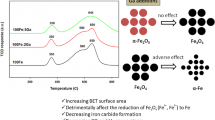Abstract
The effect of adding an oxygenated poison (O2, CO or H2O) to a hydrogen/nitrogen stream producing ammonia over a triply promoted (K2O, CaO, Al2O3) commercial catalyst is not unsurprisingly rapidly to poison the catalyst. However, immediately the oxygenated poison reacts with the catalyst and before total poisoning has occurred, which in these experiments took ∼ 10 min, there was an explosive release of ammonia producing concentrations in the gas phase in excess of the equilibrium value. This is thought to be due to a convulsive reorganisation of the surface of the catalyst in forming regions of an oxide overlayer, resulting in the expulsion of the standing surface nitrogen atom coverage as ammonia. However, in contradistinction to the observation of complete poisoning of the triply promoted catalyst shortly after switching the water (2.9%) into the hydrogen/nitrogen stream, when polycrystalline iron was used as the catalyst, after the initial pulse of ammonia was observed, the small quantity of water (2.9%) in the hydrogen/nitrogen stream resulted in an increased rate (∼ ×3) of ammonia synthesis which declined only slightly over the twenty minute duration of the experiment. The difference in behaviour between the triply promoted catalyst and the polycrystalline iron is thought to be due to the relative ease of reduction of the latter, so that submonolayer quantities of oxide can be stabilised on the surface of the polycrystalline iron. The promoting effect of this oxide overlayer is either structural or electronic; no distinction can be made from these experiments. The technique of injecting either O2 or CO into a hydrogen/nitrogen stream which is producing ammonia over promoted catalysts in quantities insufficient to cause complete poisoning and measuring the oxygen coverage of the catalyst to a measured decrease in the ammonia synthesis rate, appears to be a ready, in situ method for the determination of the active catalyst area.
Similar content being viewed by others
References
G. Ertl, in:Catalytic Ammonia Synthesis, ed. J.R. Jennings (Plenum Press, New York, 1991) p. 128, and references therein.
W. Mahdi, J. Schutze, G. Weinberg, R. Schoonmaker, R. Schlögl and G. Ertl, Catal. Lett. 11 (1991) 19.
G. Ertl and N. Thiele, Appl. Surf. Sci. 3 (1979) 99.
D.R. Strongin, S.R. Bare and G.A. Somorjai, J. Catal. 103 (1987) 289.
A. Nielsen, in:An Investigation on Promoted Iron Catalysts for the Synthesis of Ammonia (Gjellerup, Copenhagen, 1968).
C. Bokhoven,Proc. 2nd Radioisotope Conf., Oxford 1954, p. 53.
K.C. Waugh, Appl. Catal. 43 (1988) 315.
J.A. Almquist and C.A. Black, J. Am. Chem. Soc. 48 (1926) 2814.
P.H. Emmett and S. Brunauer, J. Am. Chem. Soc. 52 (1930) 2682.
P.W. Ussatschew, W.J. Tarakanowa and W.A. Komarov, Z. Elektrochem. 40 (1934) 647.
P.E. Hojlund Nielsen, in:Catalytic Ammonia Synthesis: Fundamentals and Practice, ed. J.R. Jennings (Plenum Press, New York, 1991) p. 253.
B. Fastrup and H. Nygard Nielsen, Catal. Lett. 14 (1992) 233.
K.C. Waugh, D. Butler and B.E. Hayden, Topics in Catalysis 1 (1994), in press.
R. Schlögl, Topics in Catalysis, to be published.
K. Kishiand M.W. Roberts, Surf. Sci. 62 (1977) 252.
S.R. Bare, D.R. Strongin and G.A. Somorjai, J. Phys. Chem. 90 (1986) 4726.
Author information
Authors and Affiliations
Rights and permissions
About this article
Cite this article
Waugh, K.C., Butler, D. & Hayden, B.E. The mechanism of the poisoning of ammonia synthesis catalysts by oxygenates O2, CO and H2O: an in situ method for active surface determination. Catal Lett 24, 197–210 (1994). https://doi.org/10.1007/BF00807390
Received:
Accepted:
Issue Date:
DOI: https://doi.org/10.1007/BF00807390




